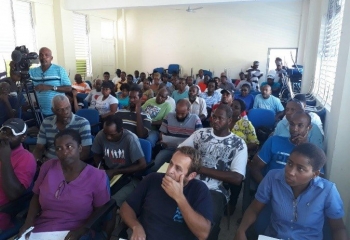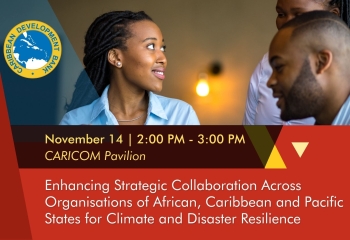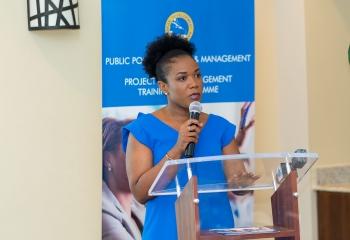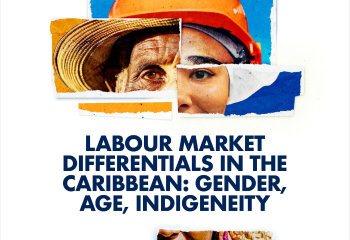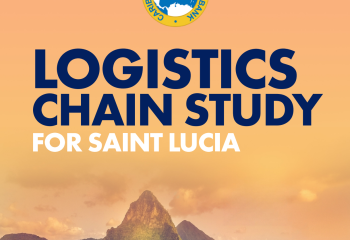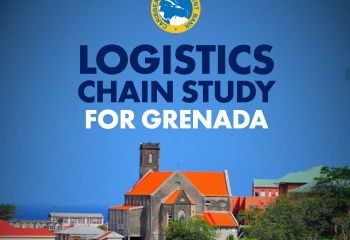The Significance of Decision-Making in the Race for a Resilient Caribbean
I wish to begin by expressing my sincerest thanks to Prime Minister Roosevelt Skerrit and the Climate Resilience Execution Agency for Dominica (CREAD) for the invitation to deliver the keynote address at this special and timely seminar on building a science and data-based agenda for decision-making on resilience in the Caribbean, hosted by the OAS Secretariat for Integral Development (SEDI) in collaboration with Inter-American Institute for Global Change Research (IAI) and CREAD. It is my pleasure to bring greetings on behalf of the President, Dr. Hyginus Leon, the Executive Management Team, and the staff of the Caribbean Development Bank (CDB). I regret not being able to be there in person, but you can rest assured I am with you, and CDB is pleased to be represented in person by Mr. Paul Saunders, Operations Officer, Environmental Sustainability. Firstly, I commend the Government and People of the Commonwealth of Dominica for demonstrating global and regional leadership in the resilience mission. These are imperatives not only for our present and our future, but for our very survival.
As I reflected on the focus of this two-day event, I considered how central decision-making is to what I will call “the Resilience Race” and would like to offer some perspectives. I describe it as a “race” because we are on a rapid course to raise our resilience to the next level. Resilience is the key to neutralising the risks facing our economies and achieving the sustainability necessary for thriving as a region. This is a race that we can win but it will take urgent individual and collective action, including accelerating the shift to evidence-based decision-making and greater employment of innovation.
I believe it is apt to start by reinforcing what we as a region are up against and the ground we need to cover to meet the sustainable development goals (SDGs). Every Caribbean citizen or resident is aware of the high level of exposure and vulnerability of the region to multiple natural hazards, whether climate-related like hurricanes and flooding or geophysical such as volcanic eruptions. As a region that is primarily made up of small islands, developing and low-lying coastal states and with a large proportion of the population living within 5 kilometres of the coast, and most economic assets found in coastal areas, the Caribbean faces severe threats from rising sea level, heatwaves, coastal flooding, coastal erosion, tropical storms and major hurricanes.
Many of us have experienced the occurrence of one – if not several – natural hazard events. We have also seen or heard of their significant environmental, economic and social impacts in the region. None of us can forget the magnitude of the destruction caused by earthquakes in Haiti, the explosive eruption of la Soufriere in Saint Vincent and the Grenadines, and the absolute devastation caused by Tropical Storm Erika in Dominica and Category 5 Hurricanes which have affected multiple countries in recent years. These adverse events have overturned years of hard-earned development gains, and hindered the well-being and safety of persons and communities in the affected countries.
Unfortunately, climate risks and potential impacts on the Caribbean will likely intensify in the future given that climate models indicate the continued increase in sea surface temperature, rising sea levels, and an increase in the frequency of extreme weather events, particularly major hurricanes ranging from Category 3 to 5.
This should send a strong signal about the urgency and necessity of building the Region’s resilience. Without urgent, coordinated and intensified action to reduce disaster risk and improve our ability to rebound from shock events, achievement of the SDGs is unlikely for many Caribbean countries.
This raises an important question – what are the milestones that must be reached in the race for resilience? Firstly, as countries take more and more steps to build resilience, we must ensure that the process is fully inclusive. On this occasion I wish to emphasise that we need interoperability throughout the collective resilience building course. Given its multi-dimensions, everyone would agree that the range of stakeholders playing a vital role in the creation of a resilient Caribbean is necessarily vast and must be inclusive. Sectors and systems, institutions and communities need to speak with each other. I know that it is easy to say that we need to work more collaboratively, but what should that be in practice? In their guidance on building resilient societies, the United Nations Sustainable Group affirms certain key elements of resilience building – understanding the Multidimensional Risk and Context, having Interconnected Systems, Multiple Stakeholders and Resilience Capacities. So in navigating the Resilience Race course, we need deliberate actions that cut across multiple avenues and streams including connected processes, entry points for cross-sectoral and collaborative work in problem analysis, risk assessment, and building of community adaptive capacity.
CDB has scaled up the comprehensive approach to supporting resilience building in the region. Our updated Strategic Plan 2022-24 lays out clear commitments to five key pillars of resilience: environmental, social, production, financial and institutional. These thematic areas link to priorities for development across a wide range of sectors such as energy, agriculture, water and sanitation, education, and transport, underpinned by evidence-based decision-making and innovation, including digitalisation, as key facilitators along with governance, gender equality and regional cooperation and integration as cross cutting themes. The Bank is in the process of constructing a major knowledge management initiative to help accelerate innovation-led sustainable development as we manoeuvre the race for resilience.
In collaboration with partners CDB is promoting three specific tools that better capture the Vulnerability and Resilience conditions in Small Island Developing States (SIDS) and developing countries. The CDB framework comprises: i) an Internal Resilience Capacity metric, which assesses a country’s capacity for rebounding from shock events, (ii) the Recovery Duration Adjuster (RDA), a methodology that evaluates the length of that recovery period, and iii) a Vulnerability and Resilience Assessment Tool. This framework promotes a rethinking of the eligibility criteria for concessional financing for SIDS, and it promises to generate rich, evidence-based data that will also support processes of decision-making and execution in the resilience race.
I turn to another key consideration, which is whether we have enough information to drive better decision-making or evidence to increase our confidence in our own determinations.
Historically, decision-making to reduce the impacts of the hazards which plague our countries, has - at best - been informed by quantitative risk assessment, evaluating potential risks, followed by steps to eliminate, reduce or mitigate such risks. As we navigate uncertainties about how the future will unfold as the severity with which climate-related hazard events will continue to impact us, we must strengthen our adaptive capacities to enable timely recovery from disasters. We must also improve coordination within the regional statistical system and meteorological services, and among regional and international development partners.
The foundation for resilience building and transformative development is rich, reliable data and information which is why this seminar is highly significant. Data and information drive innovation, create knowledge and inform planning and decision making for managing climate change impacts and addressing other key development issues. They form the basis for developing relevant and coherent policies, strategies and plans to reduce poverty, promote economic growth, social equity and sustainable development. This includes improving the ability to prepare for, absorb, recover from, and more successfully adapt to disruptive events. And this is not just about having the data but also understanding what the data is telling us.
It has been widely noted that SIDS lack comprehensive data to identify and attribute environmental impacts to climate change processes and to optimally formulate scenarios to aid decision-making under uncertainty. Under such circumstances, there is a risk of maladaptation, whereby interventions targeted at one location, sector, or community, result in increased vulnerability elsewhere. Let me emphasise that key economic sectors in the Caribbean, such as agriculture, water, tourism, transportation, energy and health are climate-sensitive, and therefore equal attention is warranted. Robust scientific weather and climate data and impact-based forecasting models are required to better understand current and projected climate and disaster risk on key economic sectors. Documented potential risks at the regional, national and local levels are fundamental to inform not only the design of resilient infrastructure across these various sectors, but also the development of effective early warning systems to save lives and reduce damage and loss of infrastructure, properties, and livelihoods.
Earlier this year, researchers at the University of the West Indies and the University of Bern published a paper presenting their research on the Implications for Beach Tourism in the Caribbean as a result of sea level rise under the various global climate change scenarios. Given that sandy beaches are a key factor in the decision by many to visit the Caribbean, the researchers sought to explore the cost of management strategies to mitigate the impact of the loss of beach width under the various scenarios. While the study and its findings were instructive, the authors highlighted numerous data limitations which affected the quality of information available to policy makers for decision making on adaptation strategies.
In another domain, the role of insurance in communicating the risk inherent in the development of housing and infrastructure at particular locations is most effective where data is available to permit assessment of the exposure, vulnerability and the resilience of assets, and the development of such datasets presents useful tools to influence adaptation. Such data covers a range of themes, such as the environment, geology, topography, and social and economic aspects. Combined with effective analytics, insurance pricing could be more precisely targeted.
In recent years, CDB, with the support of development partners, developed tools to help stakeholders to increase resilience of the region’s roads and water supply systems. The Roads Sector Resilience Index combined with the Road Sector Vulnerability-Resilience Matrix present an analytical framework designed to help our Borrowing Member Countries chart pathways to high resilience road networks. Similarly, the WaterRisk tool identifies opportunities and priorities to enhance climate resilience in the water supply sector. The soundness of decisions made using tools such as these is greatly enhanced by the availability of good quality data as inputs to the process. I call on all of us to support data-driven innovation across pillars of resilience as fundamental to adapting and responding appropriately to climate change conditions. New technologies offer an opportunity to make data and information more accessible, to customise products and services for interested parties, and to stimulate transfer of knowledge, creativity and innovation in our business and operations. The COVID-19 pandemic has triggered a substantial uptake in the adoption and use of new technologies. We should keep the momentum and ensure these technologies become more accessible, affordable and tailored to our regional context.
CDB is determined to continue playing its leading role in the process. We have been engaged in several productive partnerships, such as with the Climate Studies Group Mona at The University of the West Indies to prepare and publish the State of the Caribbean Climate Report in 2020. This is a high-quality reference report compiling reliable climate data and information to support planning and decision-making across multiple sectors in the Region. We are supporting the Caribbean Community Climate Change Centre in mapping vulnerable Caribbean coastal areas using LIDAR technology. LIDAR-generated data can be used, for instance, to integrate nature-based solutions into disaster risk management and coastal zone management planning in support of strengthening climate resilience in the region.
This evening, I want to stress that we cannot stay in the race, without climate change and other data and information, and continue to operate in uncertainty. Concerted and sustained efforts are necessities to support the collection, processing and dissemination of data and information that are required to build resilience and achieve sustainable development in the Region. This cannot be achieved singlehandedly. All stakeholders, whether academic institutions, governmental and non-governmental agencies, development agencies and donors, local communities, indigenous groups or vulnerable groups should be fully involved and play their parts. As such, it is paramount that strategic partnerships among key stakeholders be prioritised to harness expertise and mobilise adequate finance to strengthen institutional capacities for the production and management of data and knowledge in the region. Importantly, data gathering must involve communities and vulnerable groups. Indigenous knowledge should be factored into sustainable approaches to vulnerability reduction and resilience building.
Despite the magnitude of challenges that we are facing, I remain confident that we can collectively contribute to enhancing research, producing scientific and other data and information, advancing the creation of knowledge and making substantial progress in building a more resilient Caribbean.
As we strive to reach the finish line, we must also strive to sustain our ability to adapt as there is constant change. I thank you for your attention and wish you a very productive seminar.
